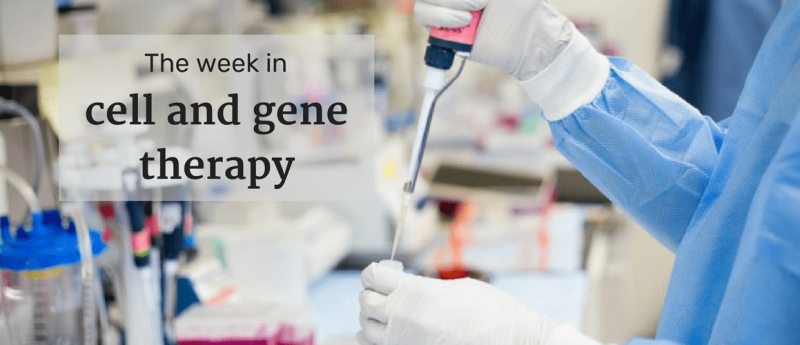Cell therapy weekly: amniotic MSCs slow progression of lung scarring in pulmonary fibrosis in mice

This week: Orgenesis (MD, USA) and Hospital Infantil Universitario Niño Jesús (Madrid, Spain) collaborate over a new point-of-care center, researchers investigate a potential biomarker for predicting responsiveness to cell therapy treatment and Takara Bio (CA, USA) a new manufacturing facility.
The news highlights:
Amniotic MSCs slow progression of lung scarring in pulmonary fibrosis in mice
Collaboration to advance development and validation of immune-oncology cell and gene therapies
Could MRI help predict the likelihood of responsiveness to neural stem cell treatment?
Construction of new manufacturing facility for gene and cell therapy products completed
Amniotic MSCs slow progression of lung scarring in pulmonary fibrosis in mice
For the first time, researchers led by investigators from the Eugenia Menni Research Centre (Brescia, Italy) have demonstrated that, in bleomycin‐challenged mice, mesenchymal stromal cells (MSCs) derived from human amniotic membrane affect B‐cell recruitment, retention and maturation in the diseased lung. By doing so, the MSCs likely contribute to blunting the progression of inflammation by preventing the formation of fibrotic aggregates and, thus, lung scarring.
Lead investigator, Anna Cargnoni (Eugenia Menni Research Centre), explained: “By modulating the B cells, the [human amniotic membrane] MSCs were able to…help blunt the progression of lung inflammation and, consequently, scarring, too. We believe these key insights into the therapeutic potential of [human amniotic membrane] MSCs provide further evidence for the potential clinical use of [human amniotic membrane] MSCs in treating [idiopathic pulmonary fibrosis] and other inflammation-related fibrotic diseases.”
Collaboration to advance development and validation of immune-oncology cell and gene therapies
Orgenesis (MD, USA) and Hospital Infantil Universitario Niño Jesús (Madrid, Spain) have announced a new research and development collaboration, which will see the latter utilize Orgenesis’ Cell and gene Therapy Biotech Platform to develop, optimize and manufacture immune-oncology cell and gene therapies, with an initial focus on T-cell and dendritic cell-based therapies. Upon successful completion of this first collaboration, a focus will then be placed on the development of the Hospital’s oncolytic-based cell therapy technology, Celyvir, which represents a new strategy for the treatment of solid metastatic tumors.
Vered Caplan, CEO of Orgenesis, commented: “Hospital Infantil Universitario Niño Jesús will be an amazing addition to our POCare Network. We believe that our POCare Technologies will enable the hospital to advance this new therapy for the treatment of solid metastatic tumors based on oncolytic virotherapy. Our [Cell and Gene Therapy] Biotech Platform enables hospitals to accelerate the clinical development of life-saving therapies and potentially bring them to market in a more time and cost-effective manner…we expect that this collaboration will allow us to further develop and validate our POCare Therapies, including immune-oncology therapies.”
Could MRI help predict the likelihood of responsiveness to neural stem cell treatment?
To date, there has been no verified biomarker for helping predict the responsiveness of an individual to a stem cell therapy based on the therapy’ mechanism of action. In a new preclinical study, researchers from Loma Linda University, Sanford Burnham Prebys Medical Discovery Institute, the Sanford Consortium for Regenerative Medicine, University of California, San Diego, University of California, Irvine (all CA, USA) and Harvard Medical School (MA, USA), demonstrate that, in the case of utilizing human neural stem cells for perinatal/neonatal cerebral hypoxic-ischemic injury, a clinically translatable MRI algorithm provides a prospective, noninvasive ‘biomarker’ for identifying subjects with lesions displaying a molecular profile indicative of responsiveness to the cell therapy’s neuroprotective mechanism of action.
In the study, the authors state: “In this report, we provide preclinical evidence to support the view that MRI with [hierarchical region splitting] (or a similar analytical method) can offer the rapid, non-invasive, early molecular and cellular mechanistic insight needed to select asphyxiated newborns that will receive therapeutic benefit from a stem cell transplant based on that cell’s known [mechanism of action] against this pathologic condition. Detection of a penumbra served as a sensitive and specific ‘biomarker’ for predicting the presence of a molecularly active salvageable niche that could both induce and be receptive to the neuroprotective actions of a stem cell intervention.”
Construction of new manufacturing facility for gene and cell therapy products completed
Takara Bio (CA, USA) has announced the completion of construction of its Center for Gene and Cell Therapy Processing II – an expansion of the Center for Gene and Cell Processing. This new, GMP-compliant manufacturing facility for gene and cell therapy products in Shiga (Japan) provides Takara Bio with additional capacity for viral vector production, aseptic filling and quality-testing facilities.
Junichi Mineno, COO at Takara Bio, commented: “Takara Bio is excited to increase our capacity to provide even more support to customers worldwide in the development of their regenerative medicine products. We have a history of developing products…for regenerative medicine research, and we are building on that history with our expanded facility and service offerings.”